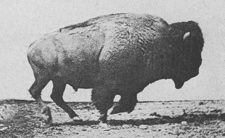When North American bison were slaughtered at the end of the 19th century, the Native Americans who relied on them experienced immediate and severe consequences that are well documented. Recent research now shows that these Indigenous peoples not only experienced a significant loss in height after the extermination, but also a rise in child mortality and a shift in their material wellbeing that is still present today.
The death of the North American bison
It is well known that the North American bison was a fundamental resource for the Native Americans of the Great Plains, the Northwest, and the Rocky Mountains. More than just food, the animal was used in almost every facet of life, from making clothing, blankets, and lodgings from their hide, to using their bones for tools. Unfortunately, it is also well known that, by the end of the 19th century, the bison was nearly extinct due to US expansion into the West.
The figures related to this are staggering. In 1870, there were at least 10 million bison in the southern herd of the North American plains, but less than 20 years later, their numbers had plummeted to only 500 wild specimens. The slaughter was mostly driven by economics and settler demand for land. At first, the introduction of cattle by US farmers led to competition for space with these roaming animals, but then, in the 1870s, they were hunted specifically for their hides, which could be more easily tanned due to developments in the leather industry.
The animals were also hunted for sport or simply shot for being in the way – railway workers would kill bison if a herd was reported near any tracks, lest they impede a train’s journey. The US Army also encouraged their deaths, as the federal government understood that culling the bison would control the Native populations. General William Tecumseh Sherman, along with many other military leaders, believed that bison hunters “did more to defeat the [Native Americans] in a few years than soldiers did in 50 years.”

American bison galloping.
The aftermath
Prior to the decline in the number of bison, the bison-reliant Indigenous populations were among the most well-off people on the American continent. There has been significant academic research to suggest that their living standards were equal to if not better than their European contemporaries. But the loss of the bison had substantial and lasting negative effects on these people.
It was well known at the time that communities of Native Americans faced significant malnutrition and hunger due to the loss of these animals. There is evidence that they had to resort to eating horses, mules, soiled food, and even old clothing to prevent starvation. The loss of this resource represented a loss in livelihoods and stability that had lasted for centuries.
According to a recent paper written by Donn L. Feir, Associate Professor in the Department of Economics at the University of Victoria, and colleagues, the bison-reliant societies experienced a 2–3 centimeter (0.8–1.2 inch) decline in height relative to other Native American nations that were not dependent on the animals. This effectively eliminated a height advantage that had been present before the slaughter.
The data for this was collected by the physical anthropologist Franz Boas between 1889 and 1903, who recorded the height, gender, and age of nearly 9,000 Native Americans.
The team have also shown that the elimination of bison resulted in substantially higher rates of child mortality (nearly 16 percent higher) in the early part of the 20th century.
The results also show that bison-dependent nations experienced a large-scale occupational displacement that has had lasting implications. By the end of the 20th century and to the present, income per capita has remained 25 percent lower on average for previously bison-dependent nations.
According to the authors, “this persistent gap cannot be explained by differences in agricultural productivity, self-governance, or application of the Dawes Act”, which compelled Native Americans to adopt European American systems of land allotment and to assimilate with the latter’s culture.
“We provide evidence that this historical shock altered the dynamic path of development for formerly bison-reliant nations”, the authors explain. “We demonstrate that limited access to credit constrained the ability of bison nations to adjust through re-specialization and migration.”
The loss of the bison was a unique historical event, but large regional economic shocks are not. As such, the experiences of the formerly bison-dependent people provide important insights into how economic shocks can have persistent implications for decades, especially in the absence of access to other financial resources.
“Large economic shocks tend to be mitigated by societies’ ability to adjust over time; however, rather than converging to the economic outcomes of other Indigenous nations, bison-reliant nations have experienced lower levels of income per capita into the present.”
The reversal in fortune demonstrated by this study provides a valuable explanation for the geographic clustering of poverty observable among the various Indigenous communities in North America. According to Feir and colleagues, this is “a fist-order contribution to understanding the processes that have resulted in the Native American communities of the Great Plains having some of the lowest incomes in the United States.”
“We argue that the rapid loss of the bison, combined with limited access to credit, altered the dynamic path of development for the formerly bison-reliant nations. This explains a long-standing puzzle regarding the relative poverty of Indigenous nations in the interior of North America today.”
The study is published in The Review of Economic Studies.
Source Link: Historic Great Plains Bison Slaughter Had Surprising Lasting Consequences For Native Americans